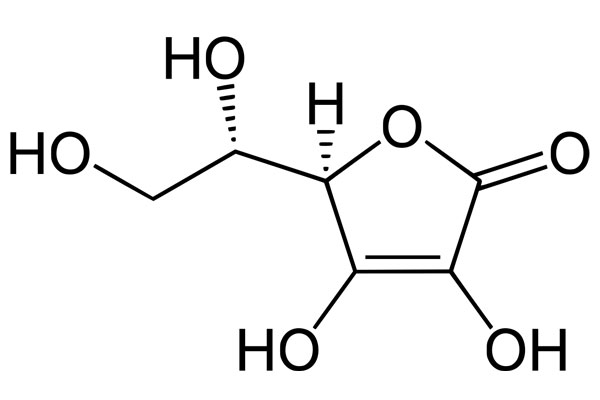Cas No: 50-81-7
EINESC No: 200-066-2
Molecular weight: 176,124 g/mol
Chemical Formula: C3H4O2
Chemical Structure:
Physical Properties
General Properties: White, solid
Odor: Odorless
Intensity: 1,69 g/cm3
Boiling point: 552,7 °C
Melting point: 190 °C
Flash point: –
Vapor pressure: –
Refraction index: –
Solubility (aquenous): completely miscible

General Properties
Ascorbic Acid, also known as vitamin C, is a fundamental nutrition soure which is found is many food groups and sold as a food additive. While the lack of it may cause several diseases, the most common is scorbutic. This disease is caused by lack of vitamin C and, in early times, it was most commonly seen in fishermen. Vıtamin C can strenghten immune system, it is also efficient in dealing with cold and influenza. Although it is said to be efficient in dealing with cancer and alzheimers in common tongue, there is no scientific evdence. Its comsumption is drastically increased in Covid-19 period. Aside from these it has an important role in several enzymes and immune system’s function. Ascorbic acid is the first chemically-produced vitamin. Although it can be disposed easly via kidneys, consuming it in high amounts may cause disturbances.
Production
Ascorbic acid is produced with glucose via two methods. One of these is Reichstein process, which is more primal way. In this process, it is made sorbitol through hydrogenation. Then, with the help of catalysts such as nickel, it is completed as a seven step reaction. Today, a modern verison if this method is used, which is two steps. Surbitol is also the starting point for this method. However, after some time, the cost is reduced by avoiding excipients.
The modern method was found in China, world’s largest ascorbic acid producer. Ascorbic acid prices have been tripled after China stopped using coal as an ingredient in 2016 due to global pressure.
Applications
It is a well-consumed chemical as a food additive of vitamin C. It is used as a food additive in both live stock and human foods. It gives food products an acidic taste. It is used for preserving color and extending shelf life in fields such as; meat production, bakery and beverage production. With its esters, it also works as an oxygen absorbant in canned foods.
Safety Measures and Toxic Levels
Ascorbic, already being a vitamin, has almost no poisoning symptoms unless consumed in high amounts. When consumed in high amounts, symptoms of indigestion, dizziness and nausea can be seen. If exposed consistently and in high amounts, it may cause iron deficiency. If contacted, it must be washed off as it is irritant to skin.